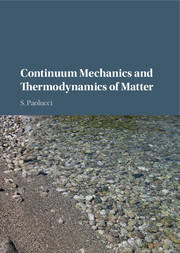1 - Introduction
Published online by Cambridge University Press: 05 February 2016
Summary
Classical continuum physics deals with media without a visible microstructure. That is, the scale of observation is large compared to the molecular scale, but small relative to other heterogeneities within the system. More modern continuum theories consider more directly the influence of microstructures; among them are micromorphic, mixture, and nonlocal theories. On the smallest scale, individual molecules are observed. Statistical mechanical theories and some micromorphic field theories may be applicable on this scale. On a slightly larger scale, the material body appears locally uniform with no distinct microstructure. This is the scale of observation on which classical continuum theories apply. On yet a larger scale of observation, large heterogeneities in space and/or time are evident. Such heterogeneities are well characterized by the solution of continuum mechanics problems at these scales.
From the atomic point of view, a macroscopic sample of matter is an agglomerate of an enormous number of nuclei and electrons. A complete mathematical description of a sample consists of the specification of suitable coordinates for each nucleus and electron; the number of such coordinates is enormous considering the magnitude of Avogadro's number of 6.0221×1023 mol−1 which gives us the number of molecules in one mole of a substance.
In contrast to the atomistic description, only a few parameters are required to describe the system macroscopically. The key to this reduction is the slowness and large scale of macroscopic measurements in comparison to the speed of atomic motions (typically of the order of 10−15 s) and atomic distance scales (typically of the order of 10−10 m). For example, some of our fastest macroscopic measurements are of the order of 10−6 s. Consequently, macroscopic measurements sense only averages of the atomic coordinates. The mathematical process of averaging eliminates coordinates and thus reduces the level of description in going from the atomic to the macroscopic level.
Of the enormous number of atomic coordinates, a very few, with unique symmetry properties, survive the statistical averaging. Certain of these are mechanical in nature (e.g., volume, shape, and components of elastic strain), others are thermal in nature (e.g., temperature and internal energy), or electrical/magnetical in nature (e.g., electric and magnetic dipole moments).
- Type
- Chapter
- Information
- Continuum Mechanics and Thermodynamics of Matter , pp. 1 - 12Publisher: Cambridge University PressPrint publication year: 2016



